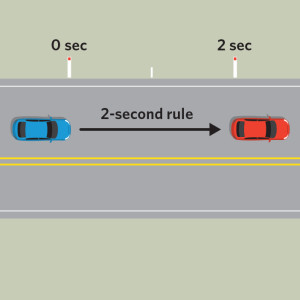It’s very important to make sure you have a safe distance between you and the vehicle in front, so you have enough time if you need to stop suddenly. It also gives you a better view of the road ahead and the hazards you need to avoid.
Several seconds will pass from the time you see the hazard until you can come to a complete stop. This is because you need time to react to the hazard and take action. Consider the time it takes to put your foot on the brake, as well as the time for the brakes to slow the vehicle down.
The faster you’re going, the longer it’ll take to stop. This means you must increase your following distance as you increase your speed.
Important!Some people take longer to react to hazards than others. If you’re tired, or your reaction times are slower than normal, you should increase your following distance. |
A good way to make sure you always keep a safe following distance is to use the 2-second rule or the 4-second rule.
Under normal conditions, the 2-second rule is an easy way to make sure you’ve allowed enough following distance between your vehicle and the vehicle in front, no matter what speed you’re travelling at.
To check if you’re travelling 2 seconds behind the vehicle in front:

The 2-second rule
In bad weather, when the road is wet or slippery, or if you’re towing a trailer, you need to increase your following distance to 4 seconds, because you’ll take longer to stop if you need to.
If the vehicle behind you is following too closely you should:
To check that you’re travelling 4 seconds behind the vehicle in front, follow the instructions for the 2‑second rule, but count from one thousand and one to one thousand and 4 instead.
Important!When you’re following another vehicle and you don’t intend to overtake them, you must leave enough space in front of your vehicle for vehicles behind you to pass. |